An inellipse is an ellipse in geometry that touches the sides of a given triangle . The simplest example is the inscribed circle . Other important examples are the Steiner Inellipse , which touches the sides of the triangle in the middle, the Mandart Inellipse and the Brocard Inellipse . They play a role in triangle geometry . If the ellipse is not restricted by special requirements, there are infinitely many inellipses for a triangle.
Since a non-degenerate conic section is uniquely determined by 5 defining pieces (points, tangents), the contact points for an inellipse of a triangle can only be specified on two sides. The point of contact on the 3rd side is then clearly defined.
Parametric representations, center point, conjugate radius

An ellipse is clearly defined by the triangle and the specification of the two contact points . (M = center of the ellipse)

The inellipse of the triangle with the corner points

and the two points of contact

on the side or can be through the rational parametric representation



describe. The contact points are determined by the specifications as follows:


The 3rd touch point is

The center of the inellipse is

The vectors


are two conjugate radiuses and the inellipse thus has the further (usual) parametric representation

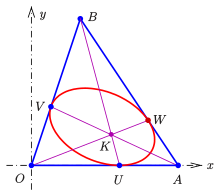
Brianchon point of an ellipse of a triangle
The Brianchon point of the inellipse (common point of the straight line ) is



With the help of the numbers , the two points of contact can be easily varied. The barriers to ensure that the contact points really lie on the two sides of the triangle. They deliver for the barriers .





Note that here are not the semi-axes of the ellipse or sides of the triangle, but parameters that define the relationship between the contact points and the corner points !



Examples
Steiner inellipse
For the points of contact are the middle of the sides and the inellipse is the Steiner inellipse (center is the center of gravity).

Inscribed circle
For
is the inscribed circle of the triangle with the center


Mandart inellipse
For
you get the Mandart ellipse of the triangle. She touches the sides in the contact points of the circles . Your center point is the center point of the triangle.

Brocard inellipse
For
you get the Brocard inellipse . It is uniquely determined by the specification of its Brianchon point in trilinear coordinates .


Derivations
- New coordinates
To prove this, one looks at the task projectively and introduces suitable new inhomogeneous - -coordinates in such a way that the desired conic section becomes the hyperbola with the coordinate axes as asymptotes and becomes the far points of the coordinate axes. The triangle points are described in the new coordinates (with square brackets) and the straight line for them has the equation . ( The reverse figure below shows that the ones used here are actually identical to those in the statement of the theorem.) We are now looking for a hyperbola with the coordinate axes as asymptotes that touches the straight line . It is easy to calculate that this is the case for the hyperbola with the equation . It touches the straight line at the point .




![{\ displaystyle A = [a, 0], B = [0, b]}](https://wikimedia.org/api/rest_v1/media/math/render/svg/e20a3ed09ce0085040d3b2cc37c6303cc137539e)





![{\ displaystyle W = [{\ tfrac {a} {2}}, {\ tfrac {b} {2}}]}](https://wikimedia.org/api/rest_v1/media/math/render/svg/9b2fe07d55a71a4127507e0c14cfa001b1f1824d)
- Coordinate transformation
The re-image of the solution found is homogeneously represented by the matrix
-
 described.
described.
One point will be on
![{\ displaystyle [x_ {1}, x_ {2}, x_ {3}]}](https://wikimedia.org/api/rest_v1/media/math/render/svg/51a96ce7336b520a13d666da01d29a958ba2ab0c)
-
 pictured if is. A point on the - plane is represented by the column vector (see homogeneous coordinates ). The representation has a distant point .
pictured if is. A point on the - plane is represented by the column vector (see homogeneous coordinates ). The representation has a distant point .
![{\ displaystyle [\ xi, \ eta]}](https://wikimedia.org/api/rest_v1/media/math/render/svg/03bdcaa9622ae82e479c0b910f97e3d0e992fa5d)


![{\ displaystyle [\ xi, \ eta, 1] ^ {T}}](https://wikimedia.org/api/rest_v1/media/math/render/svg/8e0c3209483f658ed3d8d2c2af76cceb3850cdf5)
![{\ displaystyle [\ cdots, \ cdots, 0] ^ {T}}](https://wikimedia.org/api/rest_v1/media/math/render/svg/5a472efb9e56c1741ebfa49b91fa776aa91e4b2a)
- Coordinate transformation of essential points
![{\ displaystyle U: \ [1,0,0] ^ {T} \ \ rightarrow \ (u_ {1}, u_ {2}) \, \ quad V: \ [0,1,0] ^ {T} \ \ rightarrow \ (v_ {1}, v_ {2}) \,}](https://wikimedia.org/api/rest_v1/media/math/render/svg/6c497b1f88e79030ca93f2a180c0684334572003)
![{\ displaystyle O: \ [0,0] \ \ rightarrow \ (0,0) \, \ quad A: \ [a, 0] \ rightarrow \ (a_ {1}, a_ {2}) \, \ quad B: \ [0, b] \ rightarrow \ (b_ {1}, b_ {2}) \,}](https://wikimedia.org/api/rest_v1/media/math/render/svg/25ef40c3ddad1e9bdeb9c7591474b55851361497)
- (Note that: is.)

 is the equation of the distance line of the xy plane, your distance point is .
is the equation of the distance line of the xy plane, your distance point is .
![{\ displaystyle [1, -1,0] ^ {T}}](https://wikimedia.org/api/rest_v1/media/math/render/svg/d1bcd1eb14d3670f46f18d86d73a10b44175c1e7)
![{\ displaystyle [1, -1,0] ^ {T} \ \ rightarrow \ (u_ {1} -v_ {1}, u_ {2} -v_ {2}, 0) ^ {T}}](https://wikimedia.org/api/rest_v1/media/math/render/svg/da36eb29eac79686e7f70261a0e0b4a2c1eab573)
The far point of in the - plane therefore changes into a far point of the xy plane, the far point of the straight line . This means: The two in - coordinates to parallel tangents of the hyperbola are also parallel in the xy coordinates. The points of contact of these tangents are:







![{\ displaystyle D_ {i}: [{\ frac {\ pm {\ sqrt {ab}}} {2}}, {\ frac {\ pm {\ sqrt {ab}}} {2}}] \ \ rightarrow \ {\ frac {1} {2}} {\ frac {\ pm {\ sqrt {ab}}} {1 \ pm {\ sqrt {ab}}}} \; (u_ {1} + v_ {1} , u_ {2} + v_ {2}), \;}](https://wikimedia.org/api/rest_v1/media/math/render/svg/86b368d830cf6a9e184cfd23c7cd319e89de722d)
Since the ellipse tangents are parallel in the points in the xy plane , a diameter of the ellipse, i.e. H. the midpoint of the line is the midpoint of the ellipse:





It is easy to check that the - representation



![{\ displaystyle \ M: \; [{\ frac {-ab} {2}}, {\ frac {-ab} {2}}] \}](https://wikimedia.org/api/rest_v1/media/math/render/svg/0887dfdd887cc2fd7f0aa63e224d2db5d91ecd7b)
Has. In order to find the elliptical diameter to be conjugated, one must determine the intersection points of the straight line parallel to the tangents through (it has the equation ) with the hyperbola in the - plane . It turns out
. And in xy coordinates






![{\ displaystyle E_ {i}: \ [{\ tfrac {-ab \ pm {\ sqrt {ab (ab-1)}}} {2}}, {\ tfrac {-ab \ mp {\ sqrt {ab ( ab-1)}}} {2}}] \}](https://wikimedia.org/api/rest_v1/media/math/render/svg/7d4f94526831115716ab4c492890c02510e6babf)

Two vector conjugate radiuses can be determined from the two conjugate diameters :




This results in a trigonometric parameter representation of the inellipse:

From this, as with the Steiner ellipse, the semiaxes, eccentricity, the surface area, the vertex and an equation in xy coordinates of the inellipse can be calculated.
The following applies to the contact point of the side :


![{\ displaystyle W: \ [{\ frac {a} {2}}, {\ frac {b} {2}}] \ \ rightarrow \ \ left ({\ frac {u_ {1} a + v_ {1} b} {a + b + 2}} \;, \; {\ frac {u_ {2} a + v_ {2} b} {a + b + 2}} \ right) \ ;.}](https://wikimedia.org/api/rest_v1/media/math/render/svg/1098d1b2d5ba2cbb4fe5e97491bd20422c11e6ab)
The Brianchon point of the inellipse is the common point of the three straight lines . First calculate in the - -plane as the intersection of the three straight lines: and transform the intersection into the xy-plane. It turns out






![{\ displaystyle K: \ [a, b] \ \ rightarrow \ \ left ({\ frac {u_ {1} a + v_ {1} b} {a + b + 1}} \;, \; {\ frac {u_ {2} a + v_ {2} b} {a + b + 1}} \ right) \.}](https://wikimedia.org/api/rest_v1/media/math/render/svg/25a6a51aecf46a39ee8a67c88ebd39922423804e)
The point-by-point transformation of the hyperbola provides a rational parametric representation of the inellipse:

![{\ displaystyle [\ xi, {\ frac {ab} {4 \ xi}}] \ \ rightarrow \ \ left ({\ frac {4u_ {1} \ xi ^ {2} + v_ {1} ab} {4 \ xi ^ {2} +4 \ xi + from}}, {\ frac {4u_ {2} \ xi ^ {2} + v_ {2} from} {4 \ xi ^ {2} +4 \ xi + from }} \ right) \, \ - \ infty <\ xi <\ infty \.}](https://wikimedia.org/api/rest_v1/media/math/render/svg/7c48727f90043b35469389a82c6171b2d97a6eda)
- Inscribed circle
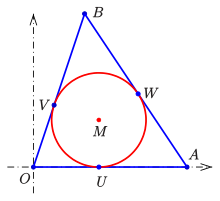
Inscribed circle of a triangle
For the inscribed circle applies and thus

-
(1) Furthermore applies in this case

-
(2) . (see picture)

If you solve both equations for , you get

-
(3)

To determine the center point, one first calculates with the help of (1) and (3)

So is

- Mandart inellipse
The parameters for the Mandart ellipse result from the information for the distances between the contact points of the circles (see circle ) and the corners.

- Brocard inellipse
The Brocard inellipse is determined by the specification of its Brianchon point . It has the simple representation in trilinear coordinates . If you convert the trilinear coordinates into the representation suitable here , you get . If, on the other hand, the parameters of an inellipse are given, the above formula for that is. If one sets the expressions for each equal and solves for , the result is










Inellipse with maximum area
- The Steiner inellipse has the largest area of all inellipses of a triangle.
- proof
From a theorem of Apollonios it follows that the area of an ellipse is equal
to the conjugate radius
-
 is (see article Steiner-Ellipse ).
is (see article Steiner-Ellipse ).
For the inellipse with the parameters (see above)

-


(It is . Note the rules for determinants!)
To avoid the roots in the calculation, it is sufficient to determine the extreme points of the function :



Because of swapping s and t one gets:


Solving the two equations for s and t yields
-
 d. H.:
d. H.:
The Steiner inellipse is the inellipse with a maximum area.
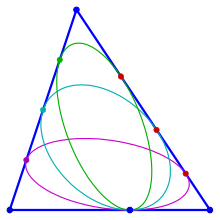
3 touching ellipses in a triangle
Web links
Individual evidence
-
↑ Imre Juhász: Control point based representation of inellipses of triangles , Annales Mathematicae et Informaticae 40 (2012) pp. 37-46, p. 44
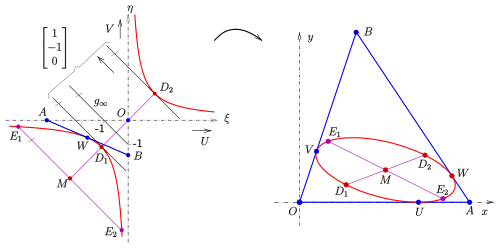






















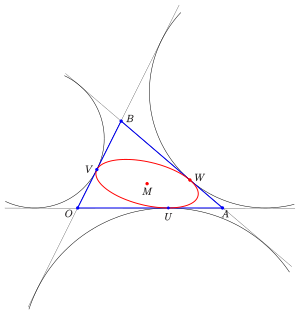















![{\ displaystyle A = [a, 0], B = [0, b]}](https://wikimedia.org/api/rest_v1/media/math/render/svg/e20a3ed09ce0085040d3b2cc37c6303cc137539e)



![{\ displaystyle W = [{\ tfrac {a} {2}}, {\ tfrac {b} {2}}]}](https://wikimedia.org/api/rest_v1/media/math/render/svg/9b2fe07d55a71a4127507e0c14cfa001b1f1824d)

![{\ displaystyle [x_ {1}, x_ {2}, x_ {3}]}](https://wikimedia.org/api/rest_v1/media/math/render/svg/51a96ce7336b520a13d666da01d29a958ba2ab0c)


![{\ displaystyle [\ xi, \ eta]}](https://wikimedia.org/api/rest_v1/media/math/render/svg/03bdcaa9622ae82e479c0b910f97e3d0e992fa5d)
![{\ displaystyle [\ xi, \ eta, 1] ^ {T}}](https://wikimedia.org/api/rest_v1/media/math/render/svg/8e0c3209483f658ed3d8d2c2af76cceb3850cdf5)
![{\ displaystyle [\ cdots, \ cdots, 0] ^ {T}}](https://wikimedia.org/api/rest_v1/media/math/render/svg/5a472efb9e56c1741ebfa49b91fa776aa91e4b2a)
![{\ displaystyle U: \ [1,0,0] ^ {T} \ \ rightarrow \ (u_ {1}, u_ {2}) \, \ quad V: \ [0,1,0] ^ {T} \ \ rightarrow \ (v_ {1}, v_ {2}) \,}](https://wikimedia.org/api/rest_v1/media/math/render/svg/6c497b1f88e79030ca93f2a180c0684334572003)
![{\ displaystyle O: \ [0,0] \ \ rightarrow \ (0,0) \, \ quad A: \ [a, 0] \ rightarrow \ (a_ {1}, a_ {2}) \, \ quad B: \ [0, b] \ rightarrow \ (b_ {1}, b_ {2}) \,}](https://wikimedia.org/api/rest_v1/media/math/render/svg/25ef40c3ddad1e9bdeb9c7591474b55851361497)


![{\ displaystyle [1, -1,0] ^ {T}}](https://wikimedia.org/api/rest_v1/media/math/render/svg/d1bcd1eb14d3670f46f18d86d73a10b44175c1e7)
![{\ displaystyle [1, -1,0] ^ {T} \ \ rightarrow \ (u_ {1} -v_ {1}, u_ {2} -v_ {2}, 0) ^ {T}}](https://wikimedia.org/api/rest_v1/media/math/render/svg/da36eb29eac79686e7f70261a0e0b4a2c1eab573)

![{\ displaystyle D_ {i}: [{\ frac {\ pm {\ sqrt {ab}}} {2}}, {\ frac {\ pm {\ sqrt {ab}}} {2}}] \ \ rightarrow \ {\ frac {1} {2}} {\ frac {\ pm {\ sqrt {ab}}} {1 \ pm {\ sqrt {ab}}}} \; (u_ {1} + v_ {1} , u_ {2} + v_ {2}), \;}](https://wikimedia.org/api/rest_v1/media/math/render/svg/86b368d830cf6a9e184cfd23c7cd319e89de722d)



![{\ displaystyle \ M: \; [{\ frac {-ab} {2}}, {\ frac {-ab} {2}}] \}](https://wikimedia.org/api/rest_v1/media/math/render/svg/0887dfdd887cc2fd7f0aa63e224d2db5d91ecd7b)


![{\ displaystyle E_ {i}: \ [{\ tfrac {-ab \ pm {\ sqrt {ab (ab-1)}}} {2}}, {\ tfrac {-ab \ mp {\ sqrt {ab ( ab-1)}}} {2}}] \}](https://wikimedia.org/api/rest_v1/media/math/render/svg/7d4f94526831115716ab4c492890c02510e6babf)







![{\ displaystyle W: \ [{\ frac {a} {2}}, {\ frac {b} {2}}] \ \ rightarrow \ \ left ({\ frac {u_ {1} a + v_ {1} b} {a + b + 2}} \;, \; {\ frac {u_ {2} a + v_ {2} b} {a + b + 2}} \ right) \ ;.}](https://wikimedia.org/api/rest_v1/media/math/render/svg/1098d1b2d5ba2cbb4fe5e97491bd20422c11e6ab)

![{\ displaystyle K: \ [a, b] \ \ rightarrow \ \ left ({\ frac {u_ {1} a + v_ {1} b} {a + b + 1}} \;, \; {\ frac {u_ {2} a + v_ {2} b} {a + b + 1}} \ right) \.}](https://wikimedia.org/api/rest_v1/media/math/render/svg/25a6a51aecf46a39ee8a67c88ebd39922423804e)

![{\ displaystyle [\ xi, {\ frac {ab} {4 \ xi}}] \ \ rightarrow \ \ left ({\ frac {4u_ {1} \ xi ^ {2} + v_ {1} ab} {4 \ xi ^ {2} +4 \ xi + from}}, {\ frac {4u_ {2} \ xi ^ {2} + v_ {2} from} {4 \ xi ^ {2} +4 \ xi + from }} \ right) \, \ - \ infty <\ xi <\ infty \.}](https://wikimedia.org/api/rest_v1/media/math/render/svg/7c48727f90043b35469389a82c6171b2d97a6eda)





















